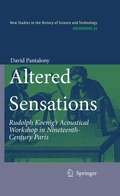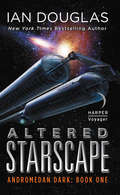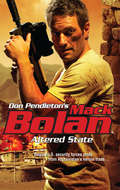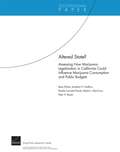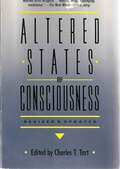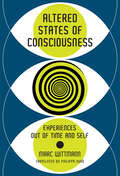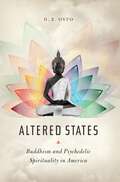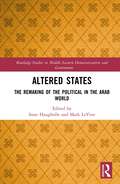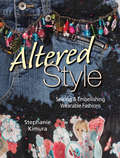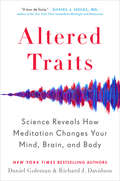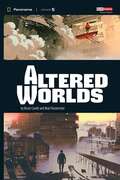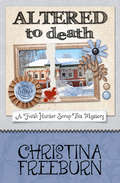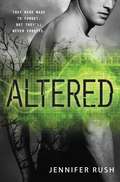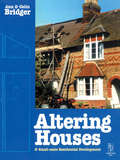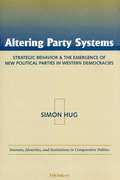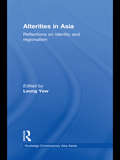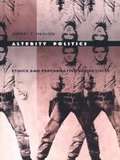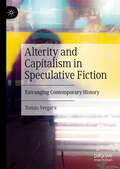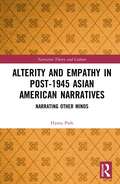- Table View
- List View
Altered Seasons: Monsoonrise
by Paul Briggs"Altered Seasons: Monsoonrise is a top recommendation for cli-fi (climate change fiction) readers seeking more depth than the usual approach to life-threatening environmental changes." - D. Donovan, Senior Reviewer, Midwest Book Review. A few weeks with no sea ice in the Arctic Ocean are enough to trigger a chain reaction that alters the Northern Hemisphere beyond recognition. Isabel Bradshaw, an engineer, tries to find security for her family in an increasingly chaotic world when they are driven out of their home on the Chesapeake Bay.
Altered Sensations: Rudolph Koenig’s Acoustical Workshop in Nineteenth-Century Paris (Archimedes #24)
by David PantalonyRudolph Koenig was one of the more prolific and colourful instrument makers in the renowned nineteenth-century precision instrument trade of Paris. Beginning his career as a violin maker, in 1858 the young Prussian immigrant shifted his talents towards the growing field of acoustics. Altered Sensations is a portrait of his vibrant atelier, a place of construction, commerce and experiment. For over forty years it was also a popular meeting place for scientists, artisans, musicians and teachers. Using archival and collection research from across North American and Europe, David Pantalony has traced the material and social influences of this space on the development of modern acoustics. In particular, he has detailed the manner in which Koenig modified, extended, spread and challenged Hermann von Helmholtz's Sensations of Tone. A large part of the research on Koenig comes from the actual products of his workshop which survive in museums and collections around the world. The second section of Altered Sensations provides a Catalogue Raisonné of Koenig's entire line of instruments, including their history, details from specific examples, locations, and references in the literature. This catalogue will serve as a practical guide for curators and researchers as well as a comprehensive overview of nineteenth-century acoustical practice.
Altered Starscape: Book One (Andromedan Dark #2)
by Ian DouglasGalaxies collide in a thrilling new series from bestselling author Ian Douglas, as the last humans in the universe face off against a new threat2162. Thirty-eight years after first contact, Lord Commander Grayson St. Clair leads the Tellus Ad Astra on an unprecedented expedition to the Galactic Core, carrying more than a million scientists, diplomats, soldiers, and AIs. Despite his reservations about their alien hosts, St. Clair is deeply committed to his people--especially after they're sucked into a black hole and spat out four billion years in the future.Civilizations have risen and fallen. The Andromeda Galaxy is drifting into the Milky Way. And Earth is most certainly a distant memory. All that matters now is survival. But as the ship's Marines search for allies amid ancient ruins and strange new planetary structures, St. Clair must wrap his mind around an enemy capable of harnessing a weapon of incomprehensible power: space itself.
Altered State
by Don PendletonKabul, Afghanistan, remains a front line within a bureaucratic civil war, where spooks, soldiers, fanatics and narcotics collide in profit and death. Added to the mix are rumors of a heroin operation now run by America's largest and most respected private security firm. With no legal remedy on hand, Mack Bolan is dispatched on a scorched-earth mission that threatens to expose more than just hand-holding deep inside the Beltway. With his identity compromised from the start, the Executioner hooks up with a seasoned DEA agent and local informant, blowing out the infrastructure of a massive narco-traffic operation brick by brick, and exposing the long arm of a traitor.
Altered State?
by Peter H. Reuter Robert J. Maccoun Beau Kilmer Rosalie Liccardo Pacula Jonathan P. CaulkinsLegalizing marijuana in California would lead to a major decline in the pretax price, but the price for consumers will depend heavily on taxes, the regulatory regime structure, and how taxes and regulations are enforced. The lower price and nonprice effects will increase consumption, but it is unclear by how much. There is much uncertainty about the effect on public budgets; even minor changes in assumptions lead to major differences in outcomes.
Altered States
by Anita BrooknerStanding on a railway platform in a Swiss resort town, sensibly clad in his Burberry raincoat and walking shoes, a man thinks he may be looking at the woman for whom he ruined his life many years earlier. Alan Sherwood, a quiet English solicitor, remembers back to a time when he stepped briefly out of character to indulge in a liaison with Sarah Miller, an intriguing but heartless distant relative--only to find himself in a series of absurd situations that culminated in his marriage to Sarah's clinging, childlike friend Angela.With her compassionate portrait of a man who has paid a terrible price for his folly, Anita Brookner gives us a novel that it at once harrowing and humane. In the traditions of Henry James and Thomas Mann, Altered States is a beautifully rendered tale of loneliness, guilt, and erotic obsession.
Altered States
by Paddy ChayefskyA novel about a young scientist's experiments to find the origin of consciousness using hallucinogenic drugs
Altered States of Consciousness
by Charles T. TartCombining the best of the humanistic and scientific traditions, this book covers the effects of drugs, yoga, self-hypnosis, mutual hypnosis, meditation, brainwave feedback, and dream consciousness. As the author states in his introduction: "The 1980s have been thought of as a conservative time. With respect to consciousness exploration by individuals in point of fact such exploration is still very much with us. It will stay with us, for better or worse, because of dissatisfaction with the limitations of our culture."
Altered States of Consciousness: Experiences Out of Time and Self
by Marc WittmannWhat altered states of consciousness—the dissolution of feelings of time and self—can tell us about the mystery of consciousness. During extraordinary moments of consciousness—shock, meditative states and sudden mystical revelations, out-of-body experiences, or drug intoxication—our senses of time and self are altered; we may even feel time and self dissolving. These experiences have long been ignored by mainstream science, or considered crazy fantasies. Recent research, however, has located the neural underpinnings of these altered states of mind. In this book, neuropsychologist Marc Wittmann shows how experiences that disturb or widen our everyday understanding of the self can help solve the mystery of consciousness. Wittmann explains that the relationship between consciousness of time and consciousness of self is close; in extreme circumstances, the experiences of space and self intensify and weaken together. He considers the emergence of the self in waking life and dreams; how our sense of time is distorted by extreme situations ranging from terror to mystical enlightenment; the experience of the moment; and the loss of time and self in such disorders as depression, schizophrenia, and epilepsy. Dostoyevsky reported godly bliss during epileptic seizures; neurologists are now investigating the phenomenon of the epileptic aura. Wittmann describes new studies of psychedelics that show how the brain builds consciousness of self and time, and discusses pilot programs that use hallucinogens to treat severe depression, anxiety, and addiction.If we want to understand our consciousness, our subjectivity, Wittmann argues, we must not be afraid to break new ground. Studying altered states of consciousness leads us directly to the heart of the matter: time and self, the foundations of consciousness.
Altered States: Buddhism and Psychedelic Spirituality in America
by Douglas OstoIn the 1960s, Americans combined psychedelics with Buddhist meditation to achieve direct experience through altered states of consciousness. As some practitioners became more committed to Buddhism, they abandoned the use of psychedelics in favor of stricter mental discipline, but others carried on with the experiment, advancing a fascinating alchemy called psychedelic Buddhism. Many think exploration with psychedelics in Buddhism faded with the revolutionary spirit of the sixties, but the underground practice has evolved into a brand of religiosity as eclectic and challenging as the era that created it. <P><P>Altered States combines interviews with well-known figures in American Buddhism and psychedelic spirituality—including Lama Surya Das, Erik Davis, Geoffrey Shugen Arnold Sensei, Rick Strassman, and Charles Tart—and personal stories of everyday practitioners to define a distinctly American religious phenomenon. The nuanced perspective that emerges, grounded in a detailed history of psychedelic religious experience, adds critical depth to debates over the controlled use of psychedelics and drug-induced mysticism. The book also opens new paths of inquiry into such issues as re-enchantment, the limits of rationality, the biochemical and psychosocial basis of altered states of consciousness, and the nature of subjectivity.
Altered States: The Remaking of the Political in the Arab World (Routledge Studies in Middle Eastern Democratization and Government)
by Sune Haugbolle Mark LeVineBuilding on Timothy Mitchell's seminal 1991 exploration of the "Limits of the State," this book brings together contributions on the state in the Arab world from the past and present in an edited volume. Altered States views the state less as a matter of people and institutions and more as sets of practices, regimes of truth, and capabilities of power, and the effects they have on those under their control. Through analysing case studies - including Tunisia, Syria, Lebanon, Egypt, Palestine, UAE, Rojova, and the Islamic State - the concept of the state is applied and questioned. This book examines the roots of policies that led to the uprisings, focusing on how the "authoritarian bargain", which helped define Arab politics, broke down with the rise of neoliberalism. It also assesses how boundaries between state and society have been redrawn, as various dynamics have brought state forces into more open conflict with citizens and each other. The rapid pace of change in the Arab world has necessitated constant modification of themes and theoretical lens of analysis. This book will, therefore, be of interest to practitioners, graduate students and academics of the Arab world, statehood, and political science.
Altered Style: Sewing & Embellishing Wearable Fashions
by Stephanie KimuraDare to be Different Gone are the days of browsing through rack after rack of new fashions at the local store looking for the perfect shirt, pair of paints or accessory. Instead, take a "shopping trip" to your own closet, a friend's closet, consignment stores, thrift shops or the sale racks. In Altered Style, author Stephanie Kimura shows you how to transform everyday garments and accessories into personalized fashions that reflect your own style and show the world who you are. Your personality will show through with: More than 30 projects for creating purses, blouses, tees, jackets and more Ideas for embellishing with buttons, sparkly crystals, colorful fabric snippets, beads and anything you come across Simple techniques, such as basic sewing, folding, bonding and drawing With a little creativity and simple embellishing, you'll be on your way to updating your wardrobe with your own style and flair. Never again will you have "nothing to wear"!
Altered Traits: Science Reveals How Meditation Changes Your Mind, Brain And Body
by Daniel Goleman Richard DavidsonTwo New York Times–bestselling authors unveil new research showing what meditation can really do for the brain. In the last twenty years, meditation and mindfulness have gone from being kind of cool to becoming an omnipresent Band-Aid for fixing everything from your weight to your relationship to your achievement level. Unveiling here the kind of cutting-edge research that has made them giants in their fields, Daniel Goleman and Richard Davidson show us the truth about what meditation can really do for us, as well as exactly how to get the most out of it. Sweeping away common misconceptions and neuromythology to open readers’ eyes to the ways data has been distorted to sell mind-training methods, the authors demonstrate that beyond the pleasant states mental exercises can produce, the real payoffs are the lasting personality traits that can result. But short daily doses will not get us to the highest level of lasting positive change—even if we continue for years—without specific additions. More than sheer hours, we need smart practice, including crucial ingredients such as targeted feedback from a master teacher and a more spacious, less attached view of the self, all of which are missing in widespread versions of mind training. The authors also reveal the latest data from Davidson’s own lab that point to a new methodology for developing a broader array of mind-training methods with larger implications for how we can derive the greatest benefits from the practice. Exciting, compelling, and grounded in new research, this is one of those rare books that has the power to change us at the deepest level.
Altered Voices
by Lucy SussexThe settings for the stories in Altered Voices whirl dizzyingly from the past to the future, from deep space to rural suburbia, from an unstoppable snowstorm to the blazing summer sun. The characters range from genetically enhanced humans to tiny sea creatures, from giants to fairies, from stone monsters to ghosts. Here is everything from humor to tragedy, fantasy to horror: an imaginative collection from nine very different writers.
Altered Worlds: Science 5. 5 Altered Worlds (Panorama)
by Bruce Coville Neal ShustermanNIMAC-sourced textbook
Altered to Death (The Faith Hunter Scrap This Mysteries #6)
by Christina FreeburnA scrapbooker looks into her West Virginia town’s history of mystery: “A delightful amateur sleuth” (Jenn McKinlay, New York Times–bestselling author of Hitting the Books). Faith Hunter is supposed to be planning her wedding, but she finds herself distracted by the town scrapbook she was commissioned to create. Eden, West Virginia’s oldest mystery—the founding family’s exodus nearly a hundred years ago—remains unsolved. A search through the family’s abandoned mansion leads to the uncovering of bones—and then someone announces a surprise heir has staked a claim. Now Faith’s determined to dig up the truth—while at the same time trying to track down a deadbeat dad who’s disappeared . . .
Altered: An Altered Saga Novella (Altered #1)
by Jennifer RushEverything about Anna's life is a secret. Her father works for the Branch, at the helm of its latest project: monitoring and administering treatments to the four genetically altered boys in the lab below their farmhouse. There's Nick, solemn and brooding; Cas, light-hearted and playful; Trev, smart and caring; and Sam . . . who's stolen Anna's heart.When the Branch decides it's time to take the boys, Sam stages an escape. Anna's father pushes her to go with them, making Sam promise to keep her away from the Branch, at all costs. On the run, with her father's warning in her head, Anna begins to doubt everything she thought she knew about herself. She soon discovers that she and Sam are connected in more ways than either of them expected. And if they're both going to survive, they must piece together the clues of their past before the Branch catches up to them and steals it all away.
Altering Frontiers: Organizational Innovations in Healthcare
by Ewan Oiry Corinne GrenierHow can healthcare systems be transformed by reimagining their multiple silos to favor processes and practices that are more responsive to local, horizontal initiatives? Altering Frontiers analyzes numerous experiences, using a multidisciplinary approach, paying attention to certain actors, collectives and organizational arrangements.Through this work, levers are identified that promote lasting transformation: recognizing the legitimacy of the practices of many who are often "invisible"; trusting those who know their intervention territory; investing in methodological support; taking advantage of tools and procedures such as instruments for strategic and managerial discussion; and developing the capacity to absorb innovative ideas and experiences that circulate within the environment.
Altering Houses and Small Scale Residential Developments
by Ann Bridger Colin Bridger'Altering Houses and Small-scale Residential Development' is a practical guide for home owners and those undertaking residential building projects. It is also useful for students and emerging professionals concerned with the built environment, especially small-scale development procedures. Undertaking house alterations can be daunting, not least because considerations of cost, design and method can simultaneously demand urgent and careful attention. In addition, there are regulations and the law to be satisfied, contracts to be entered into and a host of potential problems concerned with the form and condition of the building itself. It is a rare building which is not defective in some way, but putting things right can be very satisfying.The Bridgers' book assumes that many home owners now wish to understand more clearly what goes on when they commission contractors and consultants to convert and adapt their homes. Or course, there are also people who intend to manage a project themselves, while others may undertake work on a DIY basis, and the secret then is getting the right kind of help. This book will be invaluable in either situation because it explains how to perform certain functions yourself, yet clarifies the roles and responsibilities of the professionals who may be needed to help with the processes of buying, altering and selling a house.The economic factors in development are not overlooked since, for people who wish to develop in order to sell or let property, market conditions will be paramount, as will the forecasting and control of costs. This book provides practical guidance on these matters; it avoids theory, but does suggest further reading. It is also highly illustrated with over 100 illustrations clarifying parts of the text.The main theme of this book is altering houses but, in practice, the differences between some alterations schemes and building a new house can be relatively small. As a result, much of the material will be useful for those who wish to acquire a plot of land and undertake a modest residential development.Altering or building houses and selling them can be a complex business, covering a wide range of interrelated factors. This book will make these processes easier.
Altering Party Systems
by Simon HugNew political parties have regularly appeared in developed democracies around the world. In some countries issues focusing on the environment, immigration, economic decline, and regional concerns have been brought to the forefront by new political parties. In other countries these issues have been addressed by established parties, and new issue-driven parties have failed to form. Most current research is unable to explain why under certain circumstances new issues or neglected old ones lead to the formation of new parties. Based on a novel theoretical framework, this study demonstrates the crucial interplay between established parties and possible newcomers to explain the emergence of new political parties. Deriving stable hypotheses from a simple theoretical model, the book proceeds to a study of party formation in twenty-two developed democracies. New or neglected issues still appear as a driving force in explaining the emergence of new parties, but their effect is partially mediated by institutional factors, such as access to the ballot, public support for parties, and the electoral system. The hypotheses in part support existing theoretical work, but in part present new insights. The theoretical model also pinpoints problems of research design that are hardly addressed in the comparative literature on new political parties. These insights from the theoretical model lead to empirical tests that improve on those employed in the literature and allow for a much-enhanced understanding of the formation and the success of new parties. Simon Hug is Lecturer in Political Science, University of Geneva.
Altering Practices: Feminist Politics and Poetics of Space
by Doina PetrescuThis collection of essays addresses and defines the state of contemporary theories and practices of space: it is concerned with the growing importance of technology and communications, the effects of globalization and the change of social demands. Within the current urban and geopolitical contexts, it addresses the emergence of new social and political theories that raise questions of identity and difference in modern society. The book reiterates feminist concerns with space from the critical stance of the new millennium. With contributions from the leading theorists and thinkers from around the world representing the fields of architecture, art, philosophy and gender studies, this book has a truly international and interdisciplinary reach.
Alterities in Asia: Reflections on Identity and Regionalism (Routledge Contemporary Asia Series)
by Leong YewThis book investigates the politics of identity in Asia and explores how different groups of people inside and outside Asia have attempted to relate to the alterity of the places and cultures in the region through various modes (literary and filmic representation, scholarly knowledge, and so on) and at different points in time. Although coming from different perspectives like literary criticism, film studies, geography, cultural history, and political science, the contributors collectively argue that Asian otherness is more than the dialectical interplay between the Western self and one of its many others, and more than just the Orientalist discourse writ large. Rather, they demonstrate the existence of multiple levels of inter-Asian and intercultural contact and consciousness that both subvert as much as they consolidate the dominant ‘Western Core-Asian periphery’ framework that structures what the mainstream assumes to be knowledge of Asia. With chapters covering a wealth of topics from Korea and its Cold War history, to Australia's Asian identity crisis, this book will be of huge interest to anyone interested in critical Asian studies, Asian ethnicity, postcolonialism and Asia cultural studies. Leong Yew is an Assistant Professor in the University Scholars Programme, National University of Singapore. He is the author of The Disjunctive Empire of International Relations (2003).
Alterity Politics: Ethics and Performative Subjectivity
by Jeffrey NealonIn conventional identity politics subjective differences are understood negatively, as gaps to be overcome, as lacks of sameness, as evidence of failed or incomplete unity. In Alterity Politics Jeffrey T. Nealon argues instead for a concrete and ethical understanding of community, one that requires response, action, and performance instead of passive resentment and unproductive mourning for a whole that cannot be attained.While discussing the work of others who have refused to thematize difference in terms of the possibility or impossibility of sameness--Levinas, Butler, Derrida, Foucault, Deleuze, Guattari, Zizek, Jameson, Heidegger, Bakhtin--Nealon argues that ethics is constituted as inexorable affirmative response to different identities, not through an inability to understand or totalize the other. Alterity Politics combines this theoretical itinerary with crucial discussions of specific and diverse sites of literary and cultural production--the work of William S. Burroughs, Amiri Baraka, Andy Warhol, Ishmael Reed, Rush Limbaugh, and Vincent Van Gogh--along with analyses of the social formation of subjects as found in identity politics, and in multicultural and whiteness studies. In the process, Nealon takes on a wide variety of issues including white male anger, the ethical questions raised by drug addiction, the nature of literary meaning, and the concept of "becoming-black."In seeking to build an ethical structure around poststructuralist discourse and to revitalize the applied use of theoretical concepts to notions of performative identity, Alterity Politics marks a decisive intervention in literary theory, cultural studies, twentieth-century philosophy, and performance studies.
Alterity and Capitalism in Speculative Fiction: Estranging Contemporary History
by Tomás VergaraSpeculative fiction has been traditionally studied in Marxist literary criticism, following Darko Suvin’s paradigmatic model of science fiction, according to a hierarchical division of its multiple subgenres in terms of their assumed inherent political value. By drawing on an alternative genealogy of Marxist criticism, this book presents a non-hierarchical understanding of the estrangement connecting all varieties of speculative fiction, outlining the political potential shared across the spectrum of speculative fiction, along with the specific narrative strategies by which it critically engages with its historical context of production. This study’s main point of contention is that speculative fiction performs an estrangement effect on historical reality that can potentially render visible the role of fantasies in the organisation of capitalist social practice. This narrative effect enables an estranged perspective by which the novel interprets and conceptualises historical reality in a totalising manner.
Alterity and Empathy in Post-1945 Asian American Narratives: Narrating Other Minds (Narrative Theory and Culture)
by Hyesu ParkThis book examines how Asian American authors since 1945 have deployed the stereotype of Asian American inscrutability in order to re-examine and debunk the stereotype in various ways. By paying special attention to what narrative theorists have regarded as one of the most extraordinary aspects of fiction—its ability to give (or else deny) readers a remarkably detailed knowledge of the inner lives of their characters—this book explores deeply and systematically the specific ways Asian American narratives attribute inscrutable minds to Asian American characters, situating them at various points along a spectrum stretching between alterity and empathy. Ultimately, the book reveals the link between narrative form and larger cultural issues associated with the representation of Asian American minds, and how a nuanced investigation of narrative form can yield insights into the sociocultural embeddedness of Asian American literature under the case studies—insights that would not be available if such formal questions were by passed.

